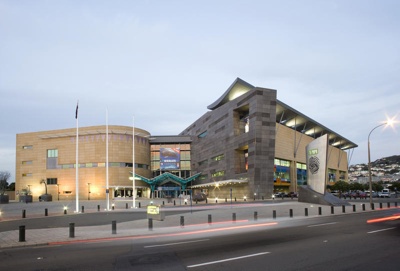Rozzie at Pisa
Shared by
Museum of New Zealand Te Papa Tongarewa
This essay originally appeared in New Zealand Art at Te Papa (Te Papa Press, 2018). A portrait of the artist’s wife, Rozzie at Pisa was painted a couple of years after Grahame Sydney moved to Mount Pisa Station near Cromwell in Central Otago. Having recently committed to working full time as an artist, the move was a way for Sydney to throw himself into the deep end not just of a painter’s life but also of his subject matter. The starkly beautiful Central Otago landscape was and has remained Sydney’s abiding subject, one that he has made distinctively his own. Sydney has often been described as New Zealand’s leading realist painter, but Rozzie at Pisa demonstrates that he knows realism is not always what it seems. It combines two of the genres that Sydney has worked in — landscape and portraiture — overlaying each of them with an air of ambiguity and unease. As a portrait, especially an intimate depiction of a loved one, the subject in the painting is strangely withdrawn. Her face is turned almost entirely away from the viewer; she is tense and seems to be straining to escape from the frame. The landscape itself is framed in numerous ways — by the window through which it is seen, by the door’s edge, by the line of the veranda cutting diagonally across the composition, and by the curtain at the right that serves to obscure and reveal it. If these framing devices emphasise the artifice of the image — the fact that this is a painting composed and constructed in a particular way, rather than a scene simply sliced from life — then what is the viewer to make of other visual puzzles in Rozzie at Pisa: the empty light socket above her head or the claw-like metal door handles that mark the divide between the painting’s interior and exterior worlds? Sydney acknowledged such questions when interviewed about the painting. ‘Is this a picture of some contentment, or is this a picture of anxiety? What is happening here? … that’s the way I think pictures should function. The mystery is important.’1 William McAloon 1 Grahame Sydney, interviewed by Reg Graham, in ‘Interview’, in The art of Grahame Sydney, Longacre Press, Dunedin, 2000, p. 172. This portrait of the artist’s wife has an air of ambiguity and unease. Graeme Sydney painted it a couple of years after he moved from Dunedin to Mount Pisa Station, near Cromwell, Central Otago. The work combines his interests in landscape and portraiture. In an interview, Sydney acknowledged the questions the painting poses: ‘Is this a picture of some contentment, or … anxiety? What is happening here? ... That’s the way I think pictures should function. The mystery is important.’ Sydney moved to Central Otago as a way to throw himself into the deep end – not just of a full-time painter’s life but of his subject matter. The starkly beautiful landscape remains Sydney’s core subject.
Ngā whakamārama
Details
-
Title
Rozzie at Pisa
-
Maker
Grahame Sydney
-
Date made
1978
-
Subject
egg tempera, gesso, panels, paintings, Clutha-Central Otago
-
Rights
All Rights Reserved
-
View source record for this item
Kei hea tēnei taonga?
Where is this item held?
-
Additional information including high resolution images may be available.
-
Location
Cable Street, Wellington
-
Website

Whare taonga | Organisation
Museum of New Zealand Te Papa Tongarewa
Ngā here ki runga i ngā whakaahua o tēnei taonga?
What can you do with images of this item?
-
You must check with Museum of New Zealand Te Papa Tongarewa to confirm terms of use and any attribution requirements, but this is our understanding:
-
Use for private study, research, criticism, review, or education
NZ Copyright law allows for the use of copyrighted works in specific circumstances. Consider what you can do under copyright law.
-
No sharing
You can't share this image without futher permission.
-
No modifying
You can't modify, remix or add to this image without further permission.
-
No commercial use
You can't use this image to make money.
-
Text adapted with permission from Te Papa and Digital NZ
Tāpirihia he kōrero anō
Improve this record
-
Can you help us? Share names, details and stories to help enrich the collection.